Called the class 103/103A/103B or more commonly Lütjens class, these were the main guided missile destroyers of the Bundesmarine (German Navy). The ships ships were built in 1966-1970 in the United States for the Federal Republic of Germany, based on the the American Charles F. Adams class. This was a sub-class called Mod.14 (Tartar-Guided Missile Destroyers SCB 155). At that time they were 10 years old, within which many defaults and limitations has been ironed out. Lütjens referred to the German Kriegsmarine great admiral Gunther Lütjens, Werner Mölders about a Luftwaffe ace, and Rommel of course referred to the German General of North Africa fame, Erwin Rommel. The destroyers served until the 1990s, assuming the bulk of the Bundesmarine defence during the late cold war era.

Genesis of the 103/Lütjens class
The Lütjens ships were envisioned as missile destroyers in early 1960s, notably to replace the old class 119 destroyers (Fletcher class). To gain time, the admiralty decided to look after existing designs. The large USN destroyers were roomy and well-tested so in 1963 the decision was made, after approaching the USN, to opt out for examples of the well proven Charles F. Adams type. Negotiations started to study a tailored version ended in 1964, and three ships were eventually ordered by the federal government on May 11, 1964.
By April 1, 1965, Bath Iron Works received the official order, and keels were laid down under the pennant DDG 28, 29 and 30. DDG 28 was laid down on March 1, 1966, later christened Lütjens at launch, by August 11, 1967. She was operational by March 23, 1969. Mölders was the second (DDG 29), to enter service, by September 20, 1969. Last DDG 30 Rommel was in service by May 2, 1970.
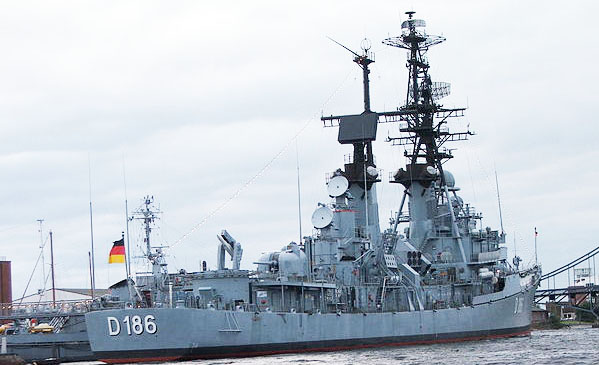
Mölders, – stern view
They were the first guided missiles ships of the Bundesmarine, equipped with a command and weapon deployment system (SATIR). Contrary to the regular American destroyers of the class, they received different radio equipment and electronic guidance systems. Externally they also had a different mack arrangement (mast-stack) and the sonar dome was different while crew quarters were improved. The class 103 were also the largest German warships in service, outside the versatile schoolship Deutschland.
Design of the Lütjens class
In their great lines, these destroyers were still very close to the Adams class: A long, roomy flush deck hull, a tall bridge and macks (two funnels and Macks). In total 23 destroyers of this class has been made since 1958-61, completed in 1964 for the last. Outside the USN they also served with Greece and Australia and were deemed the last “classic” USN class before the revolutionary Spruance. The contemporary Coontz/Farragut was slightly larger but presented the same general characteristics.
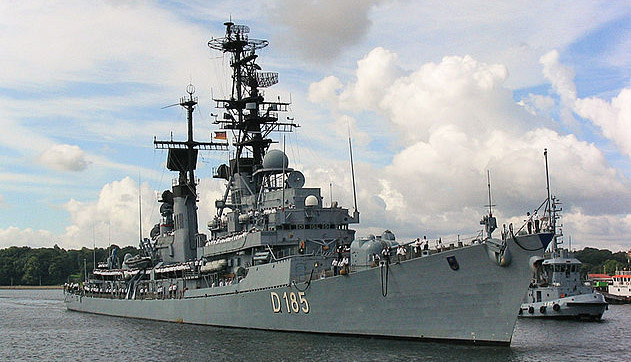
D185 Lütjens
Machinery and performances
These destroyers were given two high pressure steam turbines in separate rooms. They each developed about 25,750 kW (35,000 hp). Steam was generated by four high pressure boilers working at a pressure of 1271 psi. These boilers were separated in two boiler rooms. The turbines drove two shafts, ending with four-bladed fixed propellers 4.12 m in diameter. In these turbine rooms electric generators were also found, which fed among others the fresh water generators. Top speed observed ion trials was 35 knots and the radius of action was 4500 nautical miles at the economical cruise speed of 20 knots.
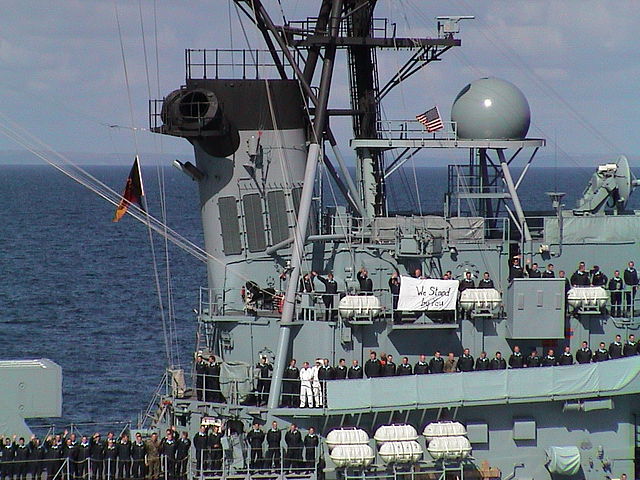
Close view of the Lütjens main bridge in 2001 – battle honors to the US Fleet
Armament
The armament changed over time and the two modifications. The 103 class configuration (original) comprised :
-2× 127 mm/54 Mk 42 Mod 7 in single turrets fwd and aft
-1× Tartar SAM mount RIM 24 B Mk 13
-1× ASROC MK16 Mod.4 ASWRL
-2× triple UTR 324 mm Mk 32 Mod 7 ASW TTs
103A/103B:
-2× 127 mm /54 Mk 42 Mod 10 in single turrets fwd and aft
-1 Mk 13 Mod 1 Standard & Harpoon SSM
-1× ASROC MK16 Mod.4 ASWRL
-2× triple UTR 324 mm Mk 32 Mod 7 ASW TTs
Final redit mid-1990s
-2× RIM-116 MK 49 x 21 vectors*
-2 SRBOC Mk36**
-2 × 20 mm Oerlikon Guns + optional MGs
These weapons are US standard, so they don’t need extra references.
*RIM-116 Rolling Airframe Missile: Standoff standard USN short range SAM, also in service with the Braunschweig class corvettes and other Bundeswehr ships.
**SBROC: BAE Systems Mark 36 Super Rapid Bloom Offboard Countermeasures Chaff and Decoy Launching System.
Electronics
The Lütjens class was equipped with the Radars AN/SPS-52-3D, AN/SPS-40, AN/SPS-67, RAY RP, and a sonar DSQS 21 B. Various fire control systems and sensors were installed during during their service. The GFCS MK-86 Mod.8 fire control system artillery was installed for the 127 mm turrets, but the main array was the MFCS MK-74 Mod.6 fire control system coupled with 2 AN/SPG-51 against air targets to feed data to the Tartar launcher. This was completed by a AN/SPG-51C FK guiding radar, AN/SPG-60 radar illuminator for the fire control system Mk.86, the AN/SPQ-9A Track-While-Search Radar for Mk.86, the DSQS-21B active/passive bug sonar, the AN/SPS-67 medium-range maritime surveillance radar, the AN/SPS-40 2D airspace surveillance and early warning radar, medium range and the AN/SPS-52 3D long-range airspace surveillance radar.
Also ws added during service a Raypath RAY RP 1225 navigation radar, with the AN/WRN-6 GPS, the URD-4 UHF direction finder, replaced later by a SFP 7200.1 in 1996, the FL 1800 electronic warfare system and the AN/URN-20 TACAN facility, for tactical air navigation.
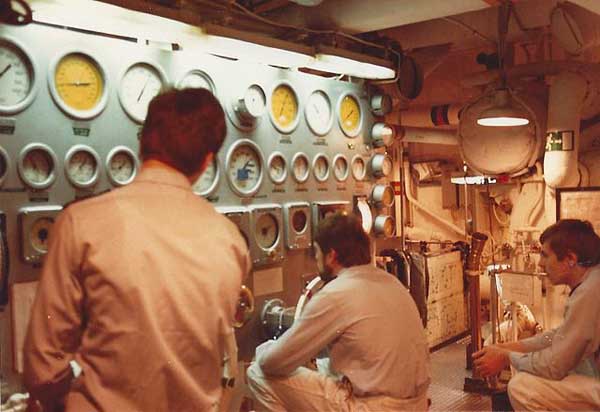
MÖlders engines control station
Accomodations
A great difference with the USN ships, German accomodations, as requested before construction in USN yards, comprised significant changes: The officers, non-commissioned officers and crews were divided lived in four main sections close to their tasks area onboard. These main sections contained certain areas of responsibility, subordinated to a main section manager.
The main section 100 was the most staffed, comprising the deck service (maritime guests, also called “11er”, “deck goats” or “Picasso Bottles”), the nautical service (navigation guests), telecommunications and signals. It was led by the SEO or Ship Operations Officer. The main section 200 for ship technology was responsible for tasks related to propulsion and the supply of energy. It was headed by the STO or ship’s officer working with the L.I. (civilian shipping assistant). This section was colloquially called the “cellar children”, “stoker” or “black feet”. This was constantly on alrt to maintain the ship’s energy supply critical for all systems. They worked in close coordination with the staff of application series 41 or steam technology section 42 or engine technology and section 43 or electrical engineering, also section 44 for the ship operating technology.
The main section 300 conerned the ship electronics and weaponry, operation and maintenance of the telecommunications, computer, radar and weapon systems. They escaped the shift work and these members were called the “hobbies” or “day laborers”. Only the operator of the central computer system was on duty in a shift.
The main section 400 concerned the supply and central services, comprising the areas of personnel management, cash register and accounting, spare parts management, catering and sanitary area. Cooks prepared five meals a day including the breakfast, second breakfast, lunch, dinner, and middle guard night shift meal). They were assisted by the supply office and the supply item catalog center. The ship’s hospital was staffed by a ship’s doctor. A dentist was carried for longer sea voyages. For internal ‘police’ the duty officer’s work was completed by the ship’s watchdog.
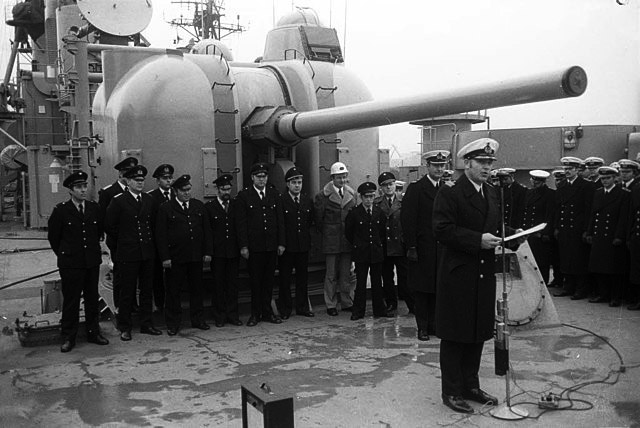
127 mm gun, Mölders
Service modernizations
The class 103/A/B made the 1st destroyer squadron in Kiel. They regularly participated in NATO operations and exercises in the Atlantic (STANAVFORLANT) and Mediterranean (STANAVFORMED). They would be decommissioned until 2003, replaced by the class 124 frigates.
103A Modifications: included the 127 mm Mod.7 turrets replaced by Mod.10 guns, and for the powerplant, the boiler system switched to light heating oil. The tartar fire control system was also upgraded, with a digital computer. The tartar missiles themselves were exchanged for a lighter standard missile system, and these modifications took the name of 103A.
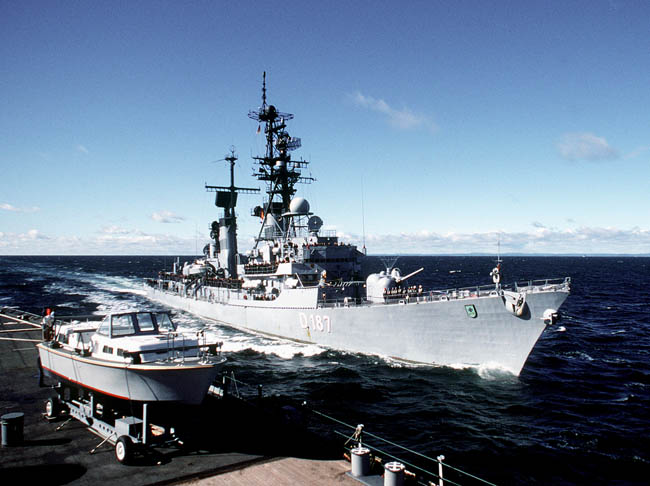
Rommel on 1st September 1986, after the 103B modifications, passing by the USS Iowa in the Atlantic.
103B Modifications: In the 1980s the three destroyers received a new deck house housing the Mk 86 artillery fire control system, replacing the ageing Mk 68. The deckhouse receive a new antenna for air targeting and radar AN/SPG-60. The front mack received an extra radome platform supporting an AN/SPQ-9 maritime target radar. Other radar systems were modernized as well. Two RIM-116 RAM systems were also installed to provide for for close-range defence, and SRBOC decoy launchers for antiship missiles and two 20 mm Oerlikon guns. The ASW weapons suite was also modernized, with an uprated combat guidance system.
In the late 1980s, another modernization of the whole weapon system was planned but never carried out, it was in the context of budget reduction, personnel and the high maintenance costs, notably the ageing propulsion system.
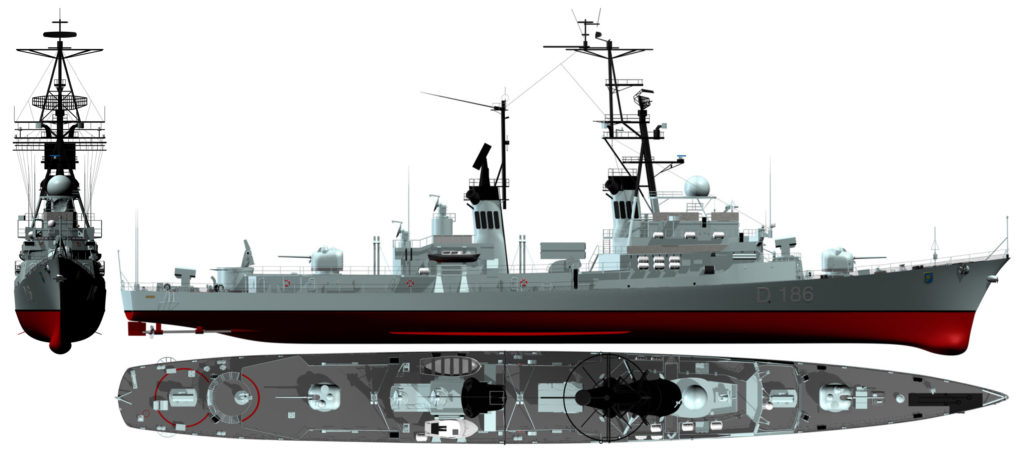
Illustration of the Mölders – Wikimedia CC
Characteristics of the Lütjens class (103 class, as of 1970)
| Displacement: | 4,720 tons (full load) |
| Dimensions: | 133.2 m (437 ft) x 14.3 m (46 ft 11 in) x 6.1 m (20 ft) |
| Powerplant: | 2 steam turbines 70,000 shp (52 MW); 4 × 1,275 psi (8,790 kPa) boilers |
| Top speed: | 33 knots (61 km/h) |
| Range: | 4,500 nautical miles (8,300 km) at 20 kn (37 km/h) |
| Crew: | 337 |
| Armament: | (See Notes) – 2 x 127mm, Tartar SAM, ASROC, 2×3 TT ASW |
| Electronics: | See notes |
Career of the Lütjens (D 185)
On March 1, 1966 at the Bath Iron Works shipyard in Bath, Maine the keel of DDG 28 was laid down. This was the first of the German order, a modification of the Charles F. Adams class, construction number 351. Gerda Lütjens, daughter-in-law of the namesake christened her before the launch on August 11, 1967. A speech was given by Karl Carstens, State Secretary of the Federal MoD. When completed she was moved to Boston for final verifications and to be handed over to the Bundesmarine.
She made a transatlantic crossing to Friedrichsort, Kiel. However due to US mresurements confusion the ship’s keel hurt the bottom, destroying the sonar. This was a bad omen for the rest, but fortunately the most serious incident so far. Frigate captain Ansgar Bethge took command and Lütjens entered service in March 22, 1969, the first in the newly created 1st destroyer squadron in Kiel. Her NATO immatriculation was D 185 and her proper radio call sign was DBYB changed in 1981 to DRAE.
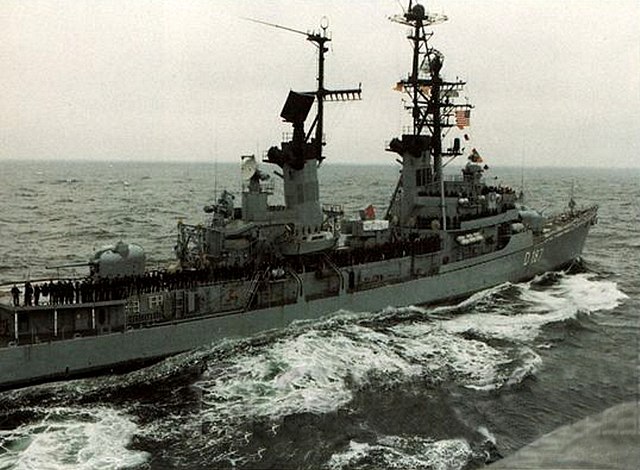
From August 1976 to August the next year, she was modernized as 103A and modernized again under the class 103B from April 1985 to March 1986 and in 1995 RAM launchers were installed on board. In September 14, 2001, a few days after the attacks, Lütjens passed the Churchill bridge, paying homage to the Americans with a Stars and Stripes running at half mast and ‘We stand by you’ banner was shown. In tital Lütjens stayed in service with the Bundesmarine for 34 years, travelling over 800,000 nautical miles. She was the staple of Bundesmarine participation in numerous NATO exercizes. She also took part in permanent NATO operations in the Atlantic (STANAVFORLANT) and Mediterranean (STANAVFORMED). She also took part in Operation Active Endeavor.
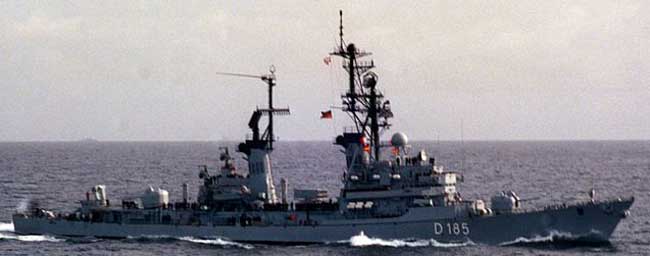
Lütjens underway in 1988
Lütjens was decommissioned at Wilhelmshaven on December 18, 2003 and March 16, 2006, was handed over to the Defense Technical Service 71 in Eckernförde to be demilitarized. She was used as a target in the Baltic Sea and from December 15, 2006, was returned to Wilhelmshaven and by August 24, 2011, she was sold for scrapping by Vebeg for 1.255 million euros. She was purchased for scrapping by the Aliağa yard on the Turkish Aegean coast, starting in August 2012.
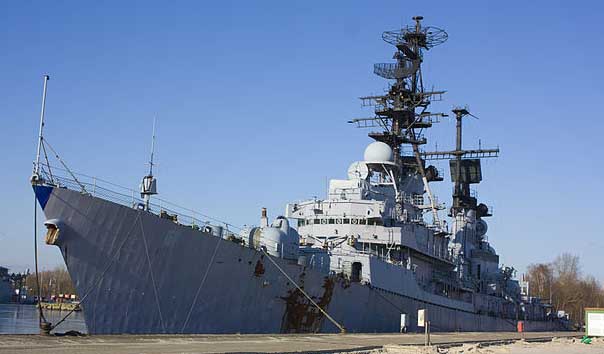
Lütjens demilitarized in February 2012
Career of the Mölders (D 186)
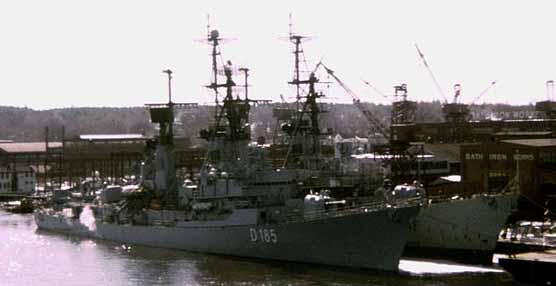
Lütjens and Mölders at Bath Iron Works 1969
Her keel was laid down at Bath Iron Works slipway (Maine) like the Lütjens on April 12, 1966, as DDG 29. She was chistened in April 13, 1968 Mölders, by the pilot’s mother, Anna Maria Mölders.
She enetered service on September 20, 1969 in Boston under command of frigate captain Günter Fromm, 1st destroyer squadron in Kiel, receiving the identifier D 186, radio call sign DBYC, later DRAF. In November 1977-April 1978 103A modernization took place, followed by 103B in April 1982-January 1983 and by 1995 the RIM-116 RAM was installed.
Mölders took part in many NATO exercises, and was part of STANAVFORLANT and STANAVFORMED.
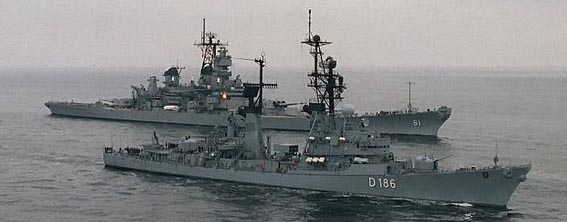
Mölders and USS Iowa in 1985
Incident: A major fire broke out on the return trip from the Mediterranean, while in the English Channel during the night of December 15, 1987. As shown by the enquiry made later, this started in the galley and spread through cable and Exhaust ducts, being so fast it was difficult to get under control. However the accompanying ships being support and the fire could be contained and eventually extinguished on early morning. She was able to reach Kiel on her own.
Kampfkraft durch Elektronik (1970) – Bundeswehr
In 1992, Mölders intercepted an East German freighter carrying loaded with Czechoslovak T-72 main battle tanks bound to the Mediterranean. Mölders also was part of Operation Sharp Guard, enforcing a weapons embargo against the Federal Republic of Yugoslavia.
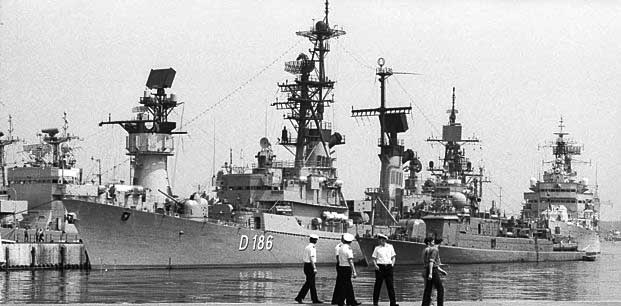
Mölders at the Kiel week 1976
After 34 years of service, Mölders was decommissioned on May 28, 2003 at Wilhelmshaven, althiugh she was already out of service from November 21, 2002. She was versed to the federal defense technology study group in Koblenz and was loaned to the German Naval Museum in Wilhelmshaven, opened to the public after some modifications as a floating museum exhibit since June 24, 2005. Since no Charles S Adams has been preserved, she is a unique living example of this 1960s class of early guided missile destroyer in Europe, but not worldwide, as the original USS Charles F Adams was preserved too.
Career of the Rommel (D 187)
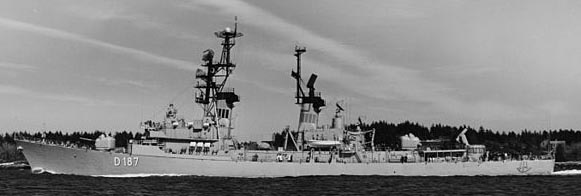
Rommel off Maine, 31 March 1970
Destroyer DDG 30 keel was laid down on August 22, 1967 at the Bath Iron Works. She was launched in the presence of MoD Gerhard Schröder on February 1, 1969, christened a day before bt by the widow of Erwin Rommel, Lucie Maria Rommel. She was moved to Boston after completion to be handed over to the Federal Navy on May 2, 1970. She was commissioned under frigate captain Klaus-Karl Stange command, the last ship to enter the 1st destroyer squadron in Kiel.
Rommel was given the identifier D 187, radio call sign DBYD (1981: DRAG). She was modernized to the 103A standard in 1979-80 and 103B in 1985-1986. by early 1996 she was given the same RAM system in replacement for the old ASROC.
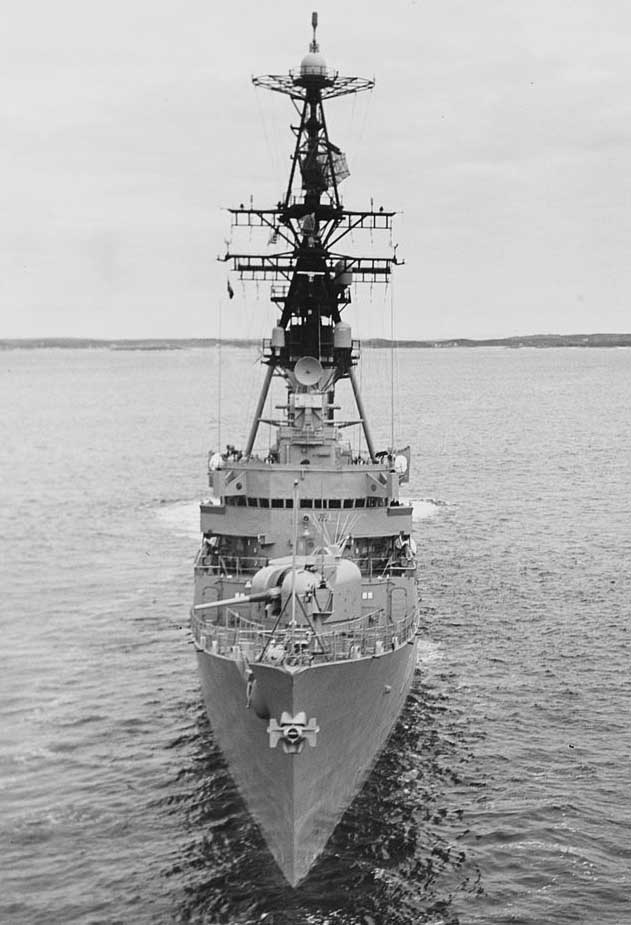
Rommel in March 1970
Rommel served for 30 years, taking active part in many NATO exercises as well as her station in STANAVFORLANT and Standing Naval Force Mediterranean in 1992-1993. In October 12-16, 1989, Rommel was in the very first German fleet after 77 years entering a ex-Soviet, now Russian port of Leningrad (St Peterstburg). She sailed with the supply ship Coburg and the frigate Niedersachsen.
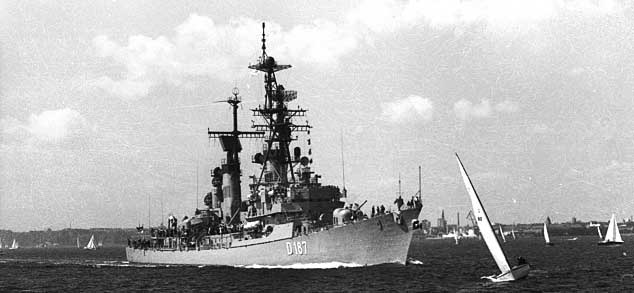
Rommel at Kiel in the 1980s
Rommel was eventually out of service on September 30. One of the motivation was… the expiring operating license for the boiler system ! Yet she was the last of the three to enter service. In November-December 1998, she was disarmed and demilitarized in Kiel and transferred on April 26, 1999, through the Canal to Wilhelmshaven for a final official decommission on June 30, 1999. She served as a spare parts warehouse for her two remaining sister ships still in service. She was eventually for scrap by the VEBEG broker company for € 600,000 to Eisen & Metall of Hamburg and tugged on 8 October 2004 in Aliağa in Turkey.
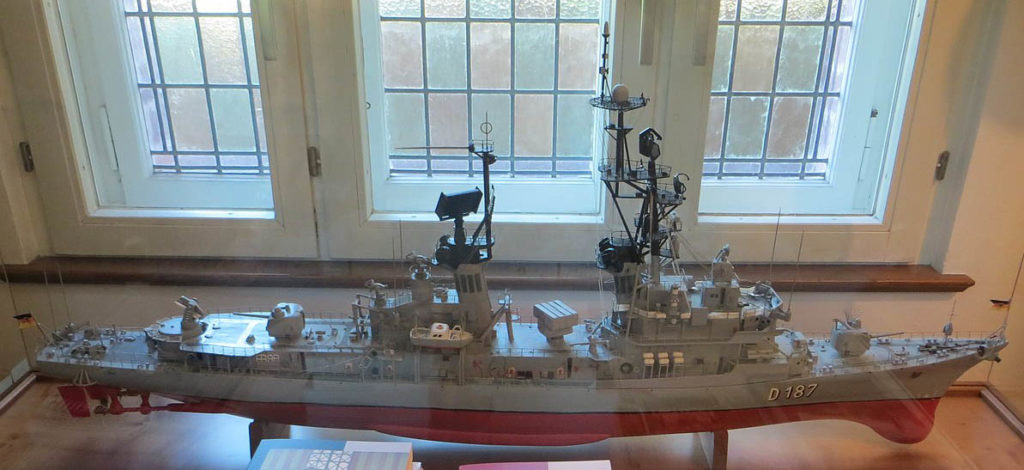
Sources/Read More
https://de.wikipedia.org/wiki/Klasse_103/103A/103B
https://www.d187.de/weitere/
https://www.d187-zerstoerer-rommel.de/bg187forum/wcf/
http://www.seaforces.org/marint/German-Navy/Destroyer/Type-119-Z-1-class.htm
http://www.navypedia.org/ships/germany/ger_dd_z1.htm
//web.archive.org/web/20040410163531/http://www.destroyersonline.com/usndd/classflet.html
//heinzalbers.org/z_1.htm
//www.schwiebert.lima-city.de/als-die-uss-claxton-zum-zerstrer-4-wurde/
//destroyerhistory.org/fletcherclass/
//www.patriotfiles.com/archive/ussclaxton/miscpics.htm
//onlinesales.randghomecare.com/index.php?main_page=product_info&products_id=20534 (cardboard kit)
Gerhard Koop/Siegfried Breyer: Die Schiffe, Fahrzeuge und Flugzeuge der deutschen Marine 1956 bis heute.
Wolfgang Harnack: Die Zerstörerflottille der Deutschen Marine von 1958 bis heute.
Dieter E. Kilian: Elite im Halbschatten. Generale und Admirale der Bundeswehr.
Die Webseiten der Bordgemeinschaft D 187.
Model Kit:

Dragon kits – Charles F Adams class 1/700
-Charles F Adams 1/700 Pit Road DDG 21 USS COCHRANE/Lütjens
-Airfix 1/600 Rommel
-Revell Rommel 1/700
-Peddinghaus 1/700 Lutjens (Markings only)
-Lütjens Class 1966 1:1250 Ixo
-Skywave 1/700 USS Charles F Adams/HMAS Perth
-Bigblueboy photo-etched 1/700 Charles F Adams


 Latest Facebook Entry -
Latest Facebook Entry -  X(Tweeter) Naval Encyclopedia's deck archive
X(Tweeter) Naval Encyclopedia's deck archive Instagram (@navalencyc)
Instagram (@navalencyc)





 French Navy
French Navy Royal Navy
Royal Navy Russian Navy
Russian Navy Armada Espanola
Armada Espanola Austrian Navy
Austrian Navy K.u.K. Kriegsmarine
K.u.K. Kriegsmarine Dansk Marine
Dansk Marine Nautiko Hellenon
Nautiko Hellenon Koninklije Marine 1870
Koninklije Marine 1870 Marinha do Brasil
Marinha do Brasil Osmanlı Donanması
Osmanlı Donanması Marina Do Peru
Marina Do Peru Marinha do Portugal
Marinha do Portugal Regia Marina 1870
Regia Marina 1870 Nihhon Kaigun 1870
Nihhon Kaigun 1870 Preußische Marine 1870
Preußische Marine 1870 Russkiy Flot 1870
Russkiy Flot 1870 Svenska marinen
Svenska marinen Søværnet
Søværnet Union Navy
Union Navy Confederate Navy
Confederate Navy Armada de Argentina
Armada de Argentina Imperial Chinese Navy
Imperial Chinese Navy Marinha do Portugal
Marinha do Portugal Mexico
Mexico Kaiserliche Marine
Kaiserliche Marine 1898 US Navy
1898 US Navy Sovietskiy Flot
Sovietskiy Flot Royal Canadian Navy
Royal Canadian Navy Royal Australian Navy
Royal Australian Navy RNZN Fleet
RNZN Fleet Chinese Navy 1937
Chinese Navy 1937 Kriegsmarine
Kriegsmarine Chilean Navy
Chilean Navy Danish Navy
Danish Navy Finnish Navy
Finnish Navy Hellenic Navy
Hellenic Navy Polish Navy
Polish Navy Romanian Navy
Romanian Navy Turkish Navy
Turkish Navy Royal Yugoslav Navy
Royal Yugoslav Navy Royal Thai Navy
Royal Thai Navy Minor Navies
Minor Navies Albania
Albania Austria
Austria Belgium
Belgium Columbia
Columbia Costa Rica
Costa Rica Cuba
Cuba Czechoslovakia
Czechoslovakia Dominican Republic
Dominican Republic Haiti
Haiti Hungary
Hungary Honduras
Honduras Estonia
Estonia Iceland
Iceland Eire
Eire Equador
Equador Iran
Iran Iraq
Iraq Latvia
Latvia Liberia
Liberia Lithuania
Lithuania Mandchukuo
Mandchukuo Morocco
Morocco Nicaragua
Nicaragua Persia
Persia San Salvador
San Salvador Sarawak
Sarawak Uruguay
Uruguay Venezuela
Venezuela Zanzibar
Zanzibar Warsaw Pact Navies
Warsaw Pact Navies Bulgaria
Bulgaria Hungary
Hungary

 Bundesmarine
Bundesmarine Dutch Navy
Dutch Navy Hellenic Navy
Hellenic Navy Marina Militare
Marina Militare Yugoslav Navy
Yugoslav Navy Chinese Navy
Chinese Navy Indian Navy
Indian Navy Indonesian Navy
Indonesian Navy JMSDF
JMSDF North Korean Navy
North Korean Navy Pakistani Navy
Pakistani Navy Philippines Navy
Philippines Navy ROKN
ROKN Rep. of Singapore Navy
Rep. of Singapore Navy Taiwanese Navy
Taiwanese Navy IDF Navy
IDF Navy Saudi Navy
Saudi Navy Royal New Zealand Navy
Royal New Zealand Navy Egyptian Navy
Egyptian Navy South African Navy
South African Navy






























 Ukrainian Navy
Ukrainian Navy dbodesign
dbodesign